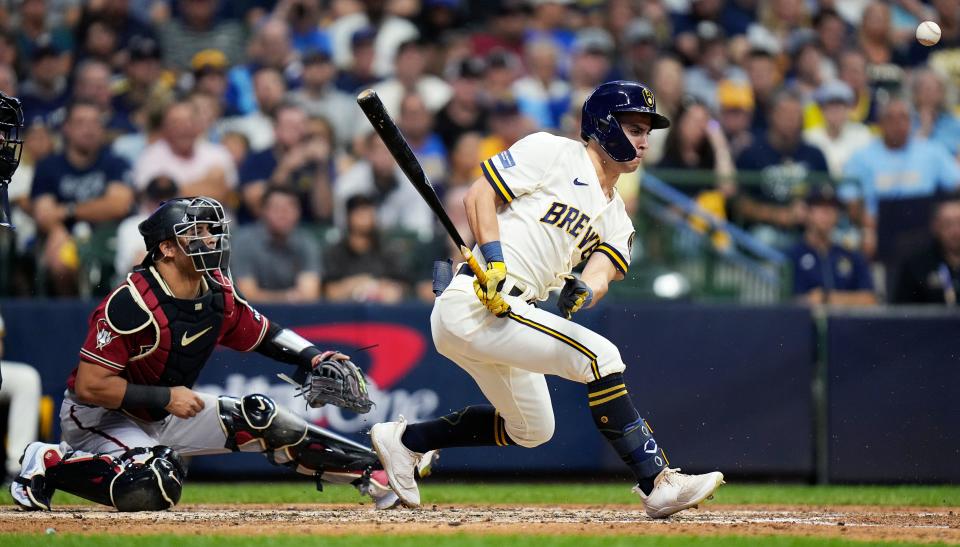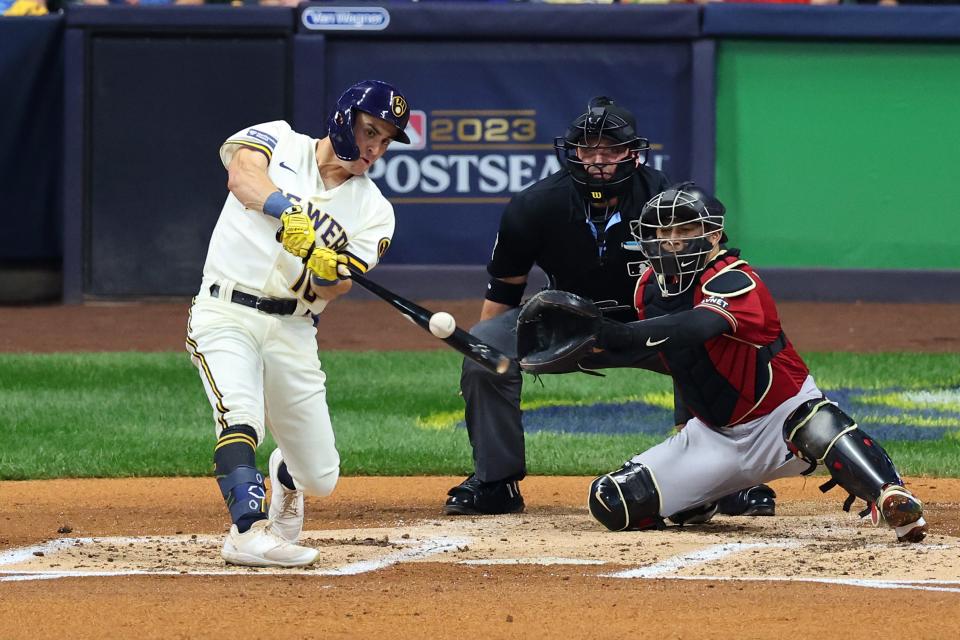Sal Frelick's rookie year was at times both red-hot and ice-cold. What should we make of it?
The start to Sal Frelick's career was incredible, and it wasn't only because of his memorable big-league debut.
Through his first 16 games, he was batting .273 with a .436 on base percentage, .546 slugging percentage and .981 on-base percentage plus slugging percentage with more walks (14) than strikeouts (11). Frelick owned the best OPS by a Brewers player through their first 16 games since Dale Sveum in 1986. Next on the list after Frelick was Ryan Braun.
The next two months, however, were an extended “welcome to the big leagues” card from pitchers. From Aug. 8 through the end of the regular season, Frelick slashed .238/.304/.293 for a .597 OPS. He had as many doubles and home runs (six total) over his final 41 games as he did over his first 16.
Part of that decline in production is just life as a rookie in the major leagues. Part of it, too, might just be baseball. Slumps happen.
But some of the underlying numbers weren't pretty. Take this one, for instance:
Frelick’s average exit velocity was 88.9 mph over his first 16 games. Over the rest of the season and including the playoffs, Frelick’s average exit velo was 81.9 mph, the lowest out of 333 batters with at least 50 balls in play in that span.
Across a 60-game sample, the Brewers saw both flashes of a potential long term top-of-the-order hitter and some very real rookie struggles.
So, what happened?

There wasn't any real difference in Frelick's plate discipline
The first place to start is to see whether Frelick’s approach at the plate changed at all, and the good news for Milwaukee is that it wasn’t really any different whether he was going good or bad.
Before Aug. 8, Frelick chased 33.1% of pitches outside the strike zone; after that, it went up only a tick to 34.8%, but Frelick also just swung a tad more often in general. He actually made more contact out of the zone (from 81.7% to 84.7%) over the final two months and his overall contact rate also went up, from 87% to 88%.
Frelick’s swinging strike rate was also almost identical between the two periods.
These numbers should at least be encouraging. Frelick knows what his approach is when he steps into the box, even as a 23-year-old in the majors for the first time, and even as teams began to attack some of his weaknesses, he was still rarely swinging and missing.

Trouble with the curve
The title of the very underwhelming 2012 baseball movie starring Clint Eastwood and Justin Timberlake, "Trouble with the Curve" was also the story of Frelick’s final eight weeks of 2023.
Right out of the gates, Frelick crushed fastballs in the zone. His first extra-base hit, a homer off Cincinnati’s Graham Ashcraft, came on a 97 mph cutter.
His first double came on a 95 mph sinker from Atlanta righty Yonny Chirinos.
Five days later, he hit his second homer on a middle-middle fastball from Pirates lefty Jose Hernandez.
You can see in these videos how Frelick's approach and timing are tailor-made to be on time for the fastball and, when the opportunity presents itself, do damage with it. Even if he's beat by the velocity, his lightning-quick hands and smooth swing plane usually allow him to at least fight the pitch off, like he does against this elevated four-seamer from Gerrit Cole.
Frelick’s first seven extra-base hits all came on fastballs – with six of those before our very arbitrary line of demarcation of Aug. 8. His three homers were all products of heaters and he had only two doubles on off-speed or breaking pitches. Even one of those two-baggers was a cue shot down the left-field line at 56 mph off the bat.
Breaking balls and off-speed was a different story for Frelick.
In 223 plate appearances, Frelick put only six non-fastballs in play at over 100 mph. Only one of those was hit in the air. The league quickly caught onto this and attacked Frelick as such.
Through Frelick’s first 16 games, he faced fastballs on more than three-fifths of pitches (61.9%). Pitchers threw him sliders or sweepers 18.6% of the time and curveballs just 6.7%.
After that? Fastball usage dipped to 50%, slider usage increased to 24.3% and curveballs were thrown 11.2% of the time.
By the time all was said and done, the contact quality numbers for Frelick told the tale.
Pitch type | Average exit velocity (mph) |
Four-seam | 89.2 |
Cutter | 87.4 |
Sinker | 81.9 |
Curveball | 81.9 |
Changeup | 78.9 |
Slider/sweeper | 78.6 |
What's causing the breaking-ball issue for Frelick?
A couple of scouts were asked what they thought might be causing Frelick's batted-ball troubles. Both suggested that less velocity throws off the timing of Frelick’s swing.
Frelick has talked about how a key part of his approach is getting on time for the fastball and, with two strikes, seeing it as deep as he can. Because he isn't jumping out as fastballs and instead lets them travel, it would seem he wouldn't be out in front and rolling over on breaking/off-speed pitches.
But instead, the scouts noticed, Frelick's swing looks different on secondary pitches than it does against fastballs. On many off-speed/breaking ball swings, his front hip is sailing wide open toward the dugout whereas he's staying compact to the ball against velocity. His weight doesn't stay back and, even though his freaky-quick hands often let him make contact, the ball typically just gets pounded into the ground.
Perhaps that changes in his second season simply because he is gaining experience. Frelick generally has very sound mechanics at the plate, one scout noted, so perhaps it's more related to approach or experience than anything.
A major-league coach mentioned last year how a hitter can get acclimated to some of what he will see from big-league velocity at Class AA, but nothing comes even close to MLB breaking stuff until you’re in the box and told to not swing at Clayton Kershaw’s slider. Hitting big-league pitching is ridiculously difficult and very few players have everything figured out right away.
Could all that this is simply be a batter getting an education on the fly in a pennant race? The numbers, after all, do back up this notion of rookies being further behind the eight ball on sliders and curves than anything else.
It sure seems as though Frelick was at least aware to some degree of what pitches he was punishing and which he wasn’t.
Before our cutoff date of Aug. 8, Frelick swung only 39.5% of the time at four-seamers, 28.6% against sinkers and 35.6% against sliders. After that, he swung at 51% of four-seamers and 41.7% of sinkers, dramatically increasing his aggression against velocity, while maintaining a nearly-identical swing rate against sliders of 36.7%. Frelick knew he was doing his damage against fastballs and, even while getting fewer of them from pitchers, made sure to attack them when he got them.
Understanding what his strengths are and attacking the types of pitches he can do damage with is an encouraging sign from a young player like Frelick, even if it didn’t quite lead to the results he would have wanted over the final weeks of the season.
That lends itself to optimism heading into year two. Frelick is a very good defender with elite contact skills that should create a solid floor for him as a player. The Brewers hope that with more experience and some adjustments at the plate, he can further unlock his ceiling.
This article originally appeared on Milwaukee Journal Sentinel: Brewers outfielder Sal Frelick had hot-then-cold rookie season

